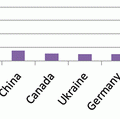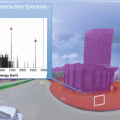Fig. 15.1
The attacks which have changed our perception of terrorist threats
There have already been a number of attempts to acquire CBRN material, which had been planned for use by terrorist groups. Since the CBRN threats show a global character, the measures needed to be taken against this danger have to be coordinated worldwide and the approach aimed at the prevention, detection and mitigation of consequences of CBRN attacks should be adopted based on a wider international cooperation of all relevant countries and stakeholders.
In addition to intentional use of CBRN materials (attacks or sabotage), we have to be prepared also for incidents and accidents which may happen in both civilians and military facilities. Successful proliferation prevention, counterforce and active defense operations can reduce the threat, decrease the number of attacks, thwart an attack, and reduce the burden on passive defense and consequence management measures.
The threat of CBRN terrorism is evolving and, with it, the risk of incidents intended to maximize the number of victims on a global scale. There is no doubt that various terrorist groups are working hard to acquire CBRN materials and the expertise to use them in their operations.
15.3 Principle Approach to Minimize the CBRN Danger
To summarize the general differences between biological, radiological, and chemical agents, the effects of chemical and radiological agents are typically recognized within minutes to hours after a release, while it may be anywhere from a couple days to a week before the effects of a biological attack are seen as symptoms (Fig. 15.2). After the attack is recognized as biological, it may take several days to confirm the type of biological agent.
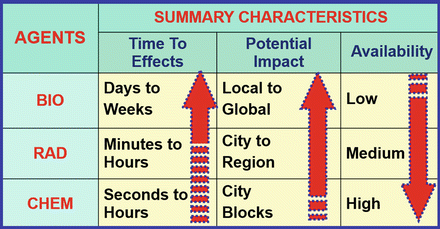

Fig. 15.2
Some specific differences between biological (BIO), radiological (RAD) and chemical (CHEM) agents in terms of their effects after the attack (based on the presentation [2])
It is relatively difficult to gain access to bio-agents of the sufficient purity and quantity which may have an impact on many people. For radiological agents, large quantities, such as high-activity radioactive sources, are relatively difficult to obtain because of the level of protection and security recently introduced in most countries. Smaller quantities, such as those found in commercial or university equipment, may be easier to access, but these small amounts could not affect a large area. In contrast, many chemical agents are commercially available, making a chemical attack perhaps the easiest method to carry out.
Common health effects associated with released chemical agents include dizziness, nausea, blindness, and disorientation. High enough concentrations or amount of these agents can cause serious injury, immobilization, and even death. The most immediate and simple mitigation measure is to move away from the chemical agent release source or cloud, filter breathing, even if this is just using a crude system such as a handkerchief, and reach fresh air. Then remove clothes, clean skin and eyes, and administer an antidote if available and applicable.
Bio-Agents (bacteria, viruses, and bio-toxins) used for malicious purpose may result in wide-spread sickness, death, panic, and to inflict adverse social impact, terror and economic consequences. These agents can cause disease by inhalation, ingestion, or skin contact. Unlike other agents, however, biological agents can also be contagious among people, and between people and animals. Bio-agents may also incubate and multiply in the body for days to weeks before visible symptoms appear and persons recognize that they are sick. There are some bio-agents, for which no vaccines are available, so infected people must be quarantined. Some biological agents, when left in the environment, can be dormant but potent for quite a long period (weeks and even years). This depends on both the specific agent, and on the environmental conditions.
Naturally occurring radiation exists everywhere but is at too low of a concentration to pose a significant threat. However, some artificial radioactive sources of higher activity are suitable for use as a crude radiological weapon, such as a dirty bomb. Such powerful sources can be found in medical radiotherapy facilities, industrial irradiators and some instruments using radioactive sources in such applications as industrial radiography, industrial gauges, soil moisture meters etc.
In order to minimize the potential CBRN danger, several steps are important including deterrence, prevention, protection, response and recovery (Fig. 15.3) [3]. These actions comprise activities before the incident (attack), during the attack and after the attack. The situation can also be illustrated in terms of CBRN defence capabilities which are characterized by seven main pillars (Fig. 15.4) [4].
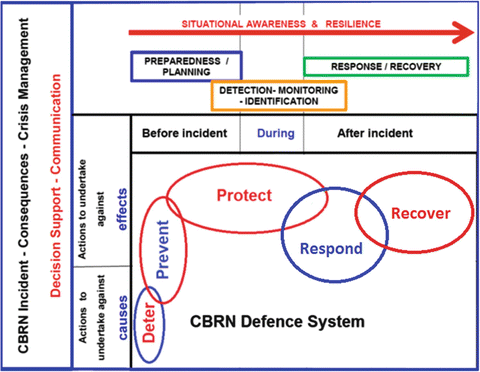
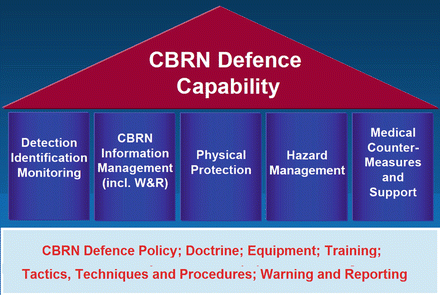

Fig. 15.3
Individual components and phases of the CBRN defence system

Fig. 15.4
Illustration of main pillars of the CBRN defence capabilities
15.3.1 EU Action Plan to Fight the CBRN
The EU CBRN Action Plan [5] represents the main EU policy document aimed at the protection of the EU Member States against CBRN threats. The Action Plan constitutes a political commitment and may be considered as a roadmap of intentions and measures to be taken in the coming years. It recommends actions concerning prevention, detection, preparedness and response, as well as horizontal measures in the context of high-risk CBRN materials. As to its implementation, the Action Plan should be conducted with full respect for international law, including human rights and the principle of the rule of law.
In the field of biological security, the EU has achieved visible results in providing training and education for professionals working with, having access to or handling high-risk agents, including bio-safety, bio-security and bio-ethics. With respect to radiological protection and nuclear safety/security, the EU Member States reported significant progress in carrying out research into detection and response, including development of technology in the area of protection and response to radiological threats. The work has also been carried out in conducting exercises at local, regional, national, EU and international level, based on risk assessment, establishing the European network of specialised CBRN law enforcement units, setting up the Early Warning System (EWS) for law enforcement authorities for incidents related to high risk CBRN materials as well as explosives and firearms under the coordination of Europol and several Member States.
The EU Action Plan includes some specific preventing measures as (a) Developing of lists at EU level of high-risk CBRN materials; (b) Identifying and reporting suspicious transactions and behavior; (c) Enhancing security and control of high risk CBRN materials; facilities and transport infrastructure; (d) Contributing to the development of a high security culture of staff; improving information exchange, (e) Strengthening the import/export regime; (f) Enhancing the cooperation on the security of CBRN as well as dual materials.
Stay updated, free articles. Join our Telegram channel

Full access? Get Clinical Tree



